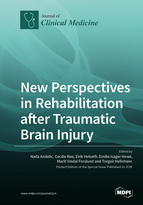New Perspectives in Rehabilitation after Traumatic Brain Injury
A special issue of Journal of Clinical Medicine (ISSN 2077-0383). This special issue belongs to the section "Brain Injury".
Deadline for manuscript submissions: closed (31 March 2022) | Viewed by 31844
Special Issue Editors
2. Research Centre for Habilitation and Rehabilitation Models and Services (CHARM), Faculty of Medicine, Institute of Health and Society, University of Oslo, 0373 Oslo, Norway
Interests: traumatic brain injury; rehabilitation; functional outcomes; health care services; unmet rehabilitation; healthcare needs
Special Issues, Collections and Topics in MDPI journals
Interests: traumatic brain injury; musculoskeletal disorders; pain; rehabilitation; health care services
2. Institute of Clinical Medicine, University of Oslo, Oslo, Norway
Interests: traumatic brain injury; neurosurgery; elderly; antithrombotics; functional outcome; cervical spine injury
Interests: traumatic brain injury; rehabilitation; cognition; functional outcomes; randomized controlled trials
Special Issues, Collections and Topics in MDPI journals
Interests: traumatic brain injury; rehabilitation; functional outcomes; health-related quality of life; healthcare service provision and needs; randomized controlled trials
Special Issues, Collections and Topics in MDPI journals
Interests: traumatic brain injury; rehabilitation; prediction; functional outcomes; neuroimaging
Special Issues, Collections and Topics in MDPI journals
Special Issue Information
Dear Colleagues,
There has been increased focus on the evaluation of the scientific knowledge base within the field of traumatic brain injury (TBI) rehabilitation. TBI rehabilitation comprises several phases, from acute medical care to post-acute care in rehabilitation facilities and chronic care in the community. Rehabilitation is a multidisciplinary effort that covers the full spectrum of medical neuroscience, cognitive neuroscience, pharmacology, brain imaging, and assistive and smart technology. A future challenge is to integrate these areas to guide TBI rehabilitation into extensive research and clinical practice. The use of smart technologies and improved brain imaging techniques has an important future in the rehabilitation of patients with cognitive difficulties and disabilities. There is also the need for broad international collaboration to establish large multinational clinical trials in order to define effective service provision and to reach consensus on the best evidence-based practice of TBI rehabilitation. With this Special Issue, we hope to encourage submissions that discuss ongoing knowledge gaps and controversies, and focus on new perspectives regarding the rehabilitation and management of TBI.
Prof. Dr. Nada Andelic
Prof. Dr. Cecilie Røe
Prof. Dr. Eirik Helseth
Dr. Emilie Isager Howe
Dr. Marit Vindal Forslund
Dr. Torgeir Hellstrøm
Guest Editors
Manuscript Submission Information
Manuscripts should be submitted online at www.mdpi.com by registering and logging in to this website. Once you are registered, click here to go to the submission form. Manuscripts can be submitted until the deadline. All submissions that pass pre-check are peer-reviewed. Accepted papers will be published continuously in the journal (as soon as accepted) and will be listed together on the special issue website. Research articles, review articles as well as short communications are invited. For planned papers, a title and short abstract (about 100 words) can be sent to the Editorial Office for announcement on this website.
Submitted manuscripts should not have been published previously, nor be under consideration for publication elsewhere (except conference proceedings papers). All manuscripts are thoroughly refereed through a single-blind peer-review process. A guide for authors and other relevant information for submission of manuscripts is available on the Instructions for Authors page. Journal of Clinical Medicine is an international peer-reviewed open access semimonthly journal published by MDPI.
Please visit the Instructions for Authors page before submitting a manuscript. The Article Processing Charge (APC) for publication in this open access journal is 2600 CHF (Swiss Francs). Submitted papers should be well formatted and use good English. Authors may use MDPI's English editing service prior to publication or during author revisions.
Keywords
- Traumatic brain injury
- Rehabilitation
- Biomarkers
- Imaging and smart technology
- New treatments
- Clinical trials







